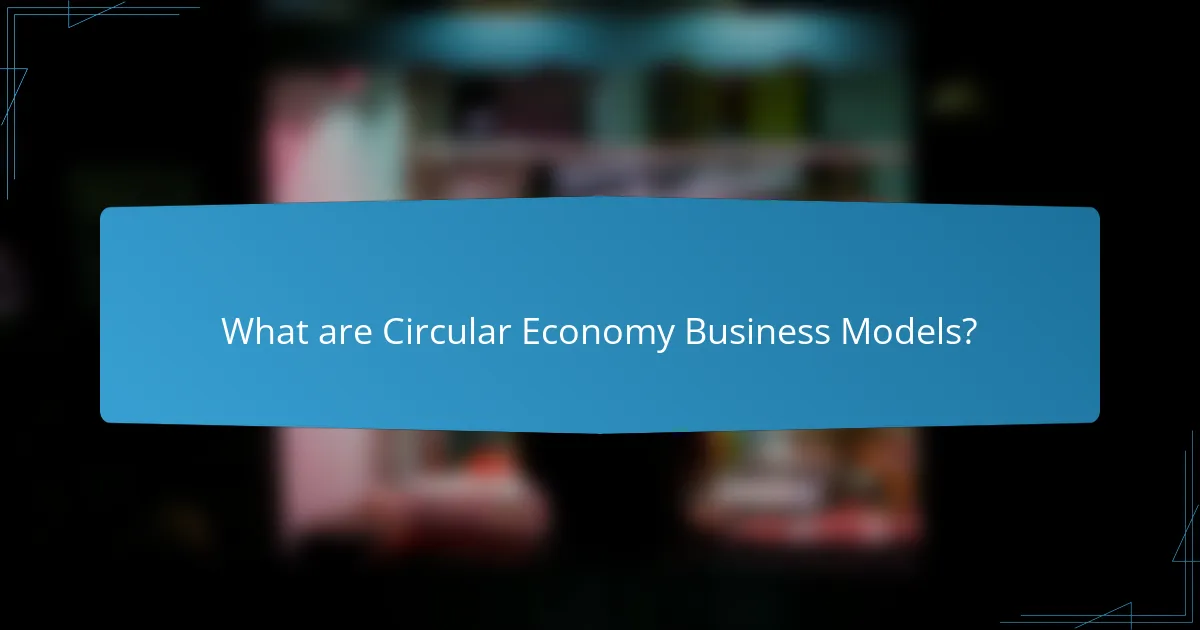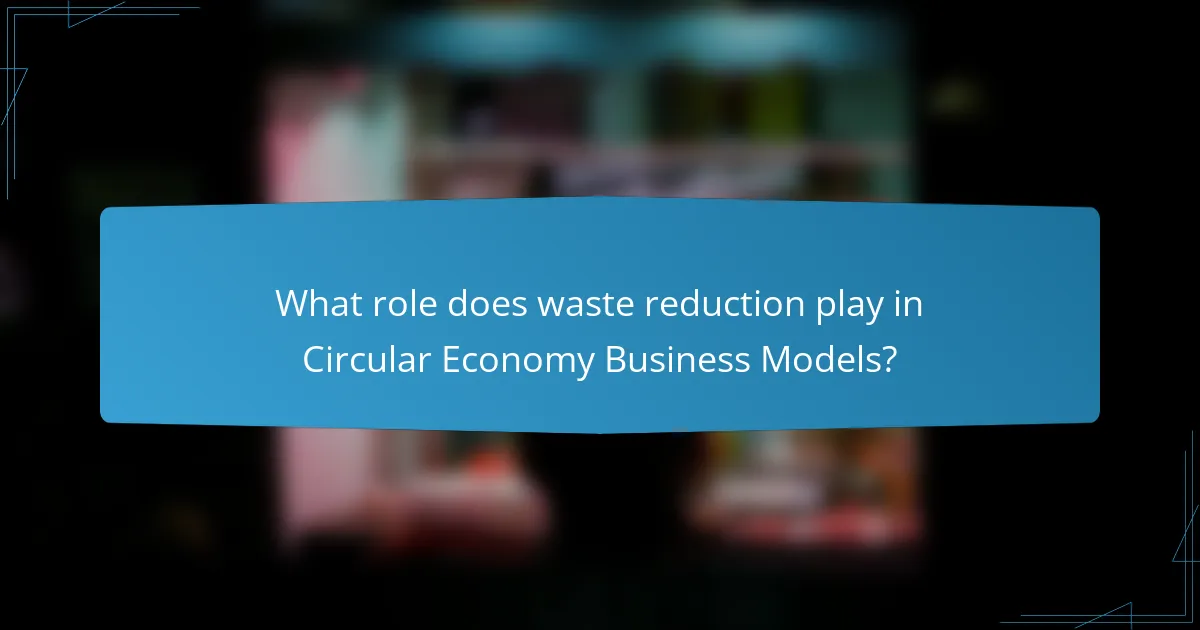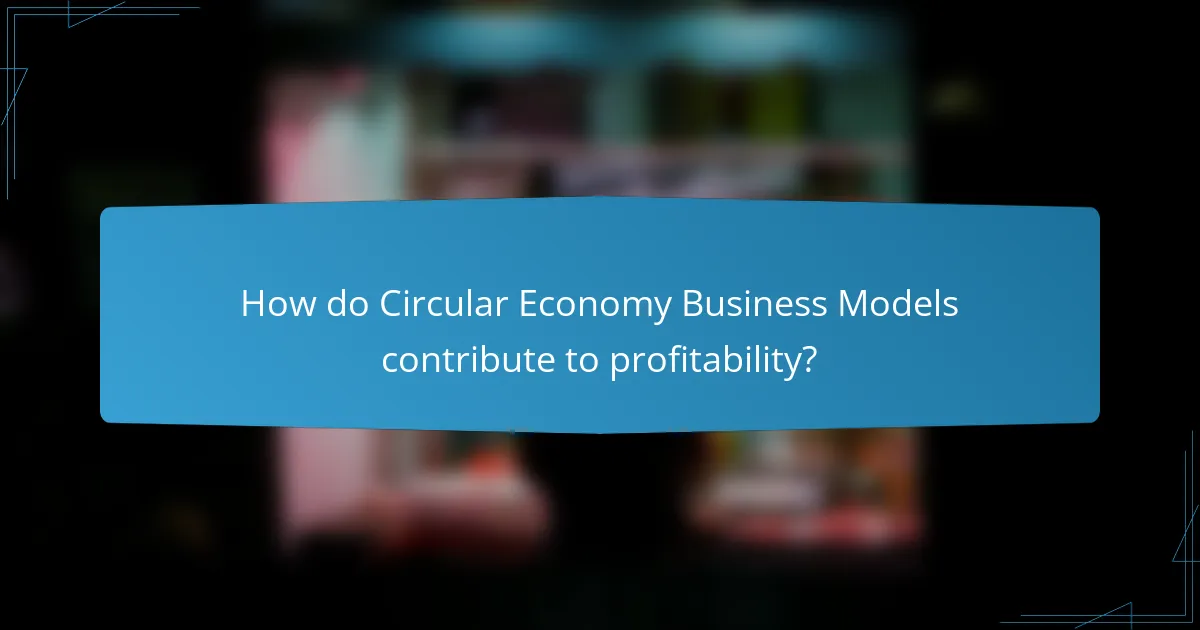Circular Economy Business Models emphasize resource efficiency and waste reduction by creating closed-loop systems where products are reused, repaired, and recycled. These models contrast with traditional linear approaches that follow a ‘take-make-dispose’ pattern, leading to significant environmental benefits and cost savings. Effective waste reduction strategies are essential, as they minimize resource consumption, lower operational costs, and enhance profitability. Research indicates that transitioning to circular models can generate substantial economic benefits, including reduced material costs and increased sales from environmentally conscious consumers. Overall, adopting circular practices promotes sustainability while driving economic growth.

What are Circular Economy Business Models?
Circular economy business models prioritize resource efficiency and waste reduction. They aim to create closed-loop systems where products are reused, repaired, and recycled. This approach contrasts with traditional linear models that follow a ‘take-make-dispose’ pattern. By focusing on sustainability, these models can reduce environmental impact. Additionally, they often lead to cost savings and new revenue streams. Companies adopting these models can enhance their competitiveness. Research shows that circular models can significantly lower material costs and waste disposal fees. This makes them both economically and environmentally beneficial.
How do Circular Economy Business Models differ from traditional models?
Circular economy business models differ from traditional models by prioritizing resource efficiency and waste reduction. Traditional models typically follow a linear approach, where resources are extracted, used, and disposed of. In contrast, circular models emphasize reusing, recycling, and regenerating materials. This shift reduces environmental impact and promotes sustainability. According to the Ellen MacArthur Foundation, transitioning to a circular economy could generate $4.5 trillion in economic benefits by 2030. Circular models also encourage product-as-a-service systems, which enhance customer engagement and create ongoing revenue streams.
What are the key principles of Circular Economy Business Models?
The key principles of Circular Economy Business Models include resource efficiency, waste reduction, and product life extension. Resource efficiency focuses on maximizing the use of materials and energy throughout the supply chain. Waste reduction aims to minimize waste generation by reusing and recycling materials. Product life extension encourages designing products for durability and reparability. These principles collectively promote sustainability and economic viability. According to the Ellen MacArthur Foundation, adopting circular economy practices can lead to significant reductions in resource consumption and environmental impact.
How do these principles enhance resource efficiency?
These principles enhance resource efficiency by promoting the sustainable use of materials and energy. They encourage the reduction of waste through recycling and reusing resources. This approach minimizes the extraction of new raw materials. It also lowers energy consumption in production processes. For example, implementing closed-loop systems can lead to significant reductions in resource use. Studies indicate that businesses adopting circular economy models can reduce operational costs by up to 30%. This efficiency ultimately leads to increased profitability while benefiting the environment.
Why is resource efficiency important in Circular Economy Business Models?
Resource efficiency is crucial in Circular Economy Business Models because it minimizes waste and maximizes the use of resources. By optimizing resource utilization, businesses can reduce costs associated with raw materials. Efficient resource management also leads to lower environmental impacts, aligning with sustainability goals. According to a report by the Ellen MacArthur Foundation, improving resource efficiency can lead to significant economic benefits. This includes potential savings of up to $1 trillion annually for the global economy by 2025. Furthermore, resource efficiency enhances competitiveness by fostering innovation in product design and processes.
What strategies can businesses implement to improve resource efficiency?
Businesses can implement strategies such as adopting energy-efficient technologies and optimizing supply chain processes to improve resource efficiency. Energy-efficient technologies reduce consumption and operational costs. For example, LED lighting can lower energy use by up to 75%. Optimizing supply chain processes enhances resource allocation and minimizes waste. Implementing just-in-time inventory systems can reduce excess stock and associated costs. Additionally, businesses can invest in employee training to promote sustainable practices. Research shows that companies engaging in sustainability training see a 20% increase in resource efficiency. Using renewable resources also contributes to long-term efficiency gains. Transitioning to renewable energy sources can cut carbon emissions significantly. These strategies collectively lead to enhanced resource efficiency and profitability.
How does resource efficiency impact overall business sustainability?
Resource efficiency significantly enhances overall business sustainability. It reduces waste and optimizes the use of materials and energy. Efficient resource use lowers operational costs, which improves profitability. A study by the Ellen MacArthur Foundation found that circular economy practices can lead to a 70% reduction in resource consumption. This reduction contributes to environmental preservation, decreasing carbon footprints and resource depletion. Businesses that adopt resource-efficient practices often gain competitive advantages. They attract environmentally conscious consumers and investors. Overall, resource efficiency is a key driver of sustainable business practices.

What role does waste reduction play in Circular Economy Business Models?
Waste reduction is essential in Circular Economy Business Models as it minimizes resource consumption and environmental impact. By reducing waste, businesses can enhance resource efficiency and lower operational costs. This approach promotes the reuse and recycling of materials, extending their lifecycle. According to the Ellen MacArthur Foundation, effective waste reduction can lead to a significant decrease in greenhouse gas emissions. Businesses adopting these models often see increased profitability through cost savings and improved brand reputation. Waste reduction strategies also foster innovation in product design and supply chain management. Overall, waste reduction is a foundational principle that drives sustainability and economic viability in circular business practices.
How can businesses effectively reduce waste?
Businesses can effectively reduce waste by implementing resource-efficient practices. They can conduct waste audits to identify areas for reduction. Adopting a circular economy model encourages reuse and recycling of materials. Training employees on waste management practices enhances awareness and accountability. Collaborating with suppliers for sustainable sourcing minimizes waste at the production stage. Utilizing technology can optimize processes and reduce excess. According to the Ellen MacArthur Foundation, businesses adopting circular models can reduce waste by up to 70%.
What are some successful examples of waste reduction in practice?
Successful examples of waste reduction in practice include the implementation of zero-waste policies by companies like Unilever. Unilever has achieved a 99% reduction in waste sent to landfills at its factories. Another example is the city of Kamikatsu in Japan, which has a comprehensive waste separation system that has led to a recycling rate of over 80%. Additionally, IKEA has committed to using only renewable or recycled materials by 2030, significantly reducing waste. The Ellen MacArthur Foundation promotes circular economy principles, which have inspired various businesses to minimize waste through innovative product design and reuse strategies. These initiatives demonstrate effective waste reduction across different sectors.
What technologies facilitate waste reduction in Circular Economy?
Technologies facilitating waste reduction in the Circular Economy include advanced recycling systems, waste-to-energy technologies, and IoT-based monitoring systems. Advanced recycling systems enhance material recovery rates. They allow for the transformation of waste into reusable materials. Waste-to-energy technologies convert non-recyclable waste into energy. This process reduces landfill use and generates power. IoT-based monitoring systems optimize resource use and waste management. They provide real-time data on waste generation and disposal. These technologies collectively contribute to minimizing waste and promoting resource efficiency.
Why is waste reduction crucial for profitability?
Waste reduction is crucial for profitability because it directly lowers operational costs. By minimizing waste, businesses can reduce expenses related to disposal and resource procurement. Efficient waste management can lead to substantial savings; for instance, companies can save up to 20% on waste disposal costs. Additionally, less waste often correlates with improved resource efficiency. This efficiency can enhance productivity and lead to higher profit margins. Studies show that organizations implementing waste reduction strategies can increase their profitability by 10% to 15%. Ultimately, waste reduction supports sustainable practices, attracting environmentally conscious consumers and investors.
How can reducing waste lead to cost savings?
Reducing waste leads to cost savings by minimizing the resources needed for production. This reduction lowers material costs. Companies also spend less on waste disposal fees. Efficient resource use can enhance operational efficiency. For example, businesses that adopt waste-reduction strategies can save up to 30% on operational costs. Additionally, reducing waste can lead to improved product quality, which can increase customer satisfaction and sales. Studies show that companies implementing waste reduction can see significant returns on investment. Overall, waste reduction contributes directly to enhanced profitability.
What metrics can businesses use to measure waste reduction success?
Businesses can use several metrics to measure waste reduction success. Common metrics include waste diversion rate, which measures the percentage of waste diverted from landfills. Another important metric is total waste generated, tracking the overall volume of waste produced. Cost savings from reduced waste disposal fees can also indicate success. Additionally, recycling rates provide insight into the effectiveness of recycling programs. Tracking the reduction of specific waste types, such as plastic or food waste, can offer targeted insights. Finally, employee engagement levels in waste reduction initiatives can reflect organizational commitment. These metrics collectively provide a comprehensive view of waste reduction efforts.

How do Circular Economy Business Models contribute to profitability?
Circular Economy Business Models contribute to profitability by enhancing resource efficiency and reducing costs. These models promote the reuse and recycling of materials, minimizing waste. By extending the lifecycle of products, companies reduce the need for new raw materials. This leads to lower operational costs and improved margins. According to a report by the Ellen MacArthur Foundation, transitioning to a circular economy could generate $4.5 trillion in economic benefits by 2030. Additionally, businesses adopting these models often attract environmentally conscious consumers, boosting sales. Overall, integrating circular practices can lead to sustainable profit growth.
What are the economic benefits of adopting Circular Economy practices?
Adopting Circular Economy practices leads to significant economic benefits. These practices enhance resource efficiency by maximizing the use of materials and minimizing waste. Companies can reduce costs associated with raw materials and waste disposal. According to the Ellen MacArthur Foundation, transitioning to a circular economy could generate $4.5 trillion in economic benefits by 2030. Additionally, businesses can create new revenue streams through innovative product designs and services. This approach also fosters job creation in recycling and remanufacturing sectors. Overall, Circular Economy practices contribute to sustainable growth and increased competitiveness in the market.
How can Circular Economy Business Models create new revenue streams?
Circular Economy Business Models can create new revenue streams by transforming waste into valuable resources. This approach encourages companies to redesign products for longevity and recyclability. By doing so, businesses can reduce material costs and enhance resource efficiency. Companies can also offer services such as product leasing or sharing, which generates recurring revenue. Furthermore, these models can tap into new markets focused on sustainability. Research shows that businesses adopting circular practices can increase profitability by up to 20%. This shift not only diversifies income sources but also strengthens brand loyalty among environmentally conscious consumers.
What is the relationship between sustainability and profitability?
Sustainability and profitability are interconnected in modern business practices. Companies that adopt sustainable practices often see cost savings through resource efficiency. For instance, reducing energy consumption lowers utility costs. Sustainable sourcing can decrease supply chain risks and enhance brand loyalty. A 2020 McKinsey report found that companies with strong sustainability performance had higher profit margins. Furthermore, consumers increasingly prefer brands committed to environmental responsibility. This shift can lead to increased sales and market share. Therefore, integrating sustainability can drive long-term profitability.
What challenges do businesses face when implementing Circular Economy Business Models?
Businesses face several challenges when implementing Circular Economy Business Models. One major challenge is the need for significant changes in supply chain management. Traditional linear models focus on one-way production and consumption, while circular models require closed-loop systems. This shift can lead to increased operational complexity.
Another challenge is the initial investment required for new technologies and processes. Many businesses may struggle to allocate funds for these changes. Additionally, there is often a lack of knowledge and expertise in circular practices among employees.
Regulatory hurdles can also impede progress. Existing regulations may not support or incentivize circular practices. Furthermore, businesses may encounter resistance from stakeholders accustomed to traditional models.
Market demand for circular products can be uncertain. Consumers may not prioritize sustainability over price. Finally, measuring the impact of circular initiatives presents difficulties. Businesses may lack the metrics to evaluate success effectively.
How can businesses overcome these challenges?
Businesses can overcome challenges in circular economy models by implementing innovative practices. They should invest in sustainable technologies to enhance resource efficiency. Training employees on circular principles is essential for fostering a culture of sustainability. Collaborating with other organizations can lead to shared resources and knowledge. Engaging customers in sustainable practices can also improve loyalty and brand reputation. According to a study by the Ellen MacArthur Foundation, companies adopting circular strategies can reduce costs by up to 30%. This demonstrates that overcoming challenges can lead to significant financial benefits alongside environmental ones.
What are common misconceptions about Circular Economy Business Models?
Common misconceptions about Circular Economy Business Models include the belief that they are only about recycling. In reality, these models encompass broader strategies like resource efficiency and product life extension. Another misconception is that they are only applicable to large corporations. Small and medium enterprises can also implement circular practices effectively. Some think circular economy models lead to higher costs. However, they often result in cost savings through improved efficiency. Additionally, there is a belief that circular economy initiatives are temporary trends. Research shows they are becoming essential for long-term sustainability. Lastly, many believe that circular economy models do not generate profit. In fact, companies adopting these models often report increased profitability through innovation and customer loyalty.
What best practices can businesses adopt for successful Circular Economy implementation?
Businesses can adopt several best practices for successful Circular Economy implementation. First, they should conduct a thorough assessment of their current resource use. This helps identify areas for improvement. Second, businesses must design products with longevity and recyclability in mind. This approach minimizes waste and maximizes resource recovery. Third, companies should establish partnerships with suppliers and customers to facilitate circular practices. Collaborations can enhance resource sharing and reduce overall waste. Fourth, implementing a take-back scheme encourages customers to return products for recycling or refurbishment. This promotes a closed-loop system. Fifth, businesses should invest in technology that supports resource tracking and waste management. Such technologies can optimize processes and reduce inefficiencies. Finally, fostering a culture of sustainability among employees is crucial. Training and awareness programs can drive engagement in circular initiatives. These practices collectively support the transition to a Circular Economy, enhancing resource efficiency and reducing waste.
Circular Economy Business Models focus on resource efficiency and waste reduction by creating closed-loop systems that prioritize the reuse, repair, and recycling of products. This approach contrasts with traditional linear models, promoting sustainability while offering economic benefits such as cost savings and new revenue streams. Key principles include maximizing resource use, minimizing waste, and extending product life, which collectively enhance overall business sustainability and profitability. The article will explore strategies for implementing these models, the economic advantages they provide, and the challenges businesses may face in transitioning to a circular economy.